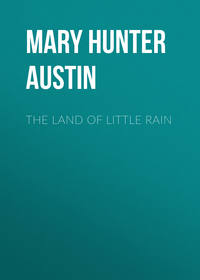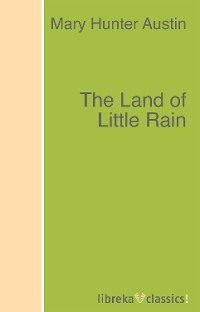 полная версия
полная версияCalifornia
The pines of Monterey, though characteristic enough of the locality to take on its identifying name, are thoroughly plebeian: prolific, quick-growing, branching like candelabra when young; but in a hundred years or so their wide limbs, studded with persistent cones, take on something of the picturesque eccentricity that may be noticed among the old in rural neighbourhoods. They grow freely back into the hills till they are warned away from the cañons by the more sequestered palo colorado. The Monterey pine is one of the long-needled varieties, but of a too open growth perhaps, or too flexile to have any voice but a faint rustling echo of the ocean. The hill above Monterey, crowned with them, is impressive enough; they look lofty and aloof and dark against the sky, but growing in a wood they are seen to be too spindling and sparse-limbed to be interesting. The oaks do better by the landscape, all of the encinas variety, bearing stiff clouds of evergreen foliage in lines simple enough to compose beautifully with the slow scimitar sweep of the bay and the round cloud-masses that, gathering from the sea, hang faintly pearled above the horizon. There are no redwoods on the peninsula; straggling lines of them look down from Palo Corona on Carmel Bay, walking one after another, with their odd tent-shaped tops and long branches all on the windward side, like a procession of friars walking against the wind. On the Santa Cruz coast, and in small groups near Carmel, grows the tan bark oak, not a true oak, but of the genus Pasania, whose nearest surviving congeners are no nearer than Siam. How it came here, survivor of an earlier world, or drifting in on the changing Japanese current, no one knows. Apparently no one cares, for the only use the Santa Crucians have found for it is to tan shoe leather.
Three little towns have taken root on the Peninsula: two on the bay side, the old pueblo of Monterey with its white-washed adobes still contriving to give character to the one wide street; Pacific Grove, utterly modern, on the surf side of Punta de Pinos, a town which began, I believe, as a resort for the churchly minded – a very clean and well-kept and proper town, absolutely exempt, as the deeds are drawn to assure us, "from anything having a tendency to lower the moral atmosphere," a town where the lovely natural woods have given place to houses every fifty feet or so, all nicely soldered together with lines of bright scarlet and clashing magentas and rosy pinks of geraniums and pelargoniums in a kind of predetermined cheerfulness; in short, a town where nobody would think of living who wanted anything interesting to happen to him. Above it on the hill, the Presidio commands the naked slope, fronting toward Santa Cruz, raking the open roadstead with its guns. It was under this hill on the harbour side, where a little creek still runs a rill in the rainy season, that Viscaino heard the first mass in California, and nearly two hundred years later, Padre Serra set up the cross.
On June 30, 1770, that being the Holy Day of Pentecost, was founded here the Mission of San Carlos Borromeo, afterward transplanted for sufficient reasons, over the hill six miles away, on Carmel River. The town is full of reminders of the days of the Spanish Occupation, when it was the capital of Alta California. Old gardens here have still the high adobe walls, old houses the long galleries and little wrought-iron balconies; times yet the tide rises in the streets of the town, and still the speech is soft.
It is also possible to buy tomales there and enchiladas and chile concarne which will for the moment restore your faith in certain conceptions of a hereafter that of late have lost popularity.
Half a mile back from the beach, and divided from the town by the old cemetery, in a deep alluvial flat grown to great oaks and creeping sycamores, is situated one of the famous winter resorts of the world, Hôtel Del Monte. I can recommend it with great freedom to those curiously constituted people who have to have an excuse for being out of doors. The Del Monte drives and golf links are said by those who have used them, to provide such excuse in its most compelling form. Those who suffer under no such necessity will do well to take the white road climbing the hill out of old Monterey, and drop down the other side of it into Carmel.
From the top of this hill the lovely curve of the bay, disappearing far to the north under a violet mist, is pure Greek in its power to affect the imagination. Its blueness is the colour that lies upon the Gulf of Dreams; the ivory rim of the dunes, the shadowed blue of the terraces set on a sudden all the tides of recollection back on Salonica, Lepanto, the hill of Athens. You are reconciled for a moment to the chance of history which whelmed the colourful days of the Spanish Occupation. They could never have lived up to it.
But once on the Carmel side of the peninsula, regret comes back very poignantly. The bay is a miniature of the other, intensified, the connoisseur's collection, – blue like the eye of a peacock's feather, fewer dunes but whiter, a more delicate tracery on them of the beach verbena, hills of softer contours, tawny, rippled like the coat of a great cat sleeping in the sun. Carmel Valley breaks upon the bay by way of the river which chokes and bars, runs dry in summer or carries the yellow of its sands miles out in winter a winding track across the purple inlet. It is a little valley and devious, reaching far inland. Above its source the peaks of Santa Lucia stand up; for its southern bulwark, Palo Corona. Willows, sycamores, elder, wild honeysuckle, and great heaps of blackberry vines hedge the path of its waters.
Where the valley widens behind the low barrier that shuts out the sea, sits the Mission of San Carlos Borromeo, once the spiritual capital of Alta California. Here Junipero Serra, and after him the other Padre Presidentes, held the administration of Mission affairs, and from here he wandered forth on foot, up and down this whole coast from San Diego to Solano, with pacification and the seeds of civilisation. Here on the walls, faintly to be traced beneath the scorn of time, he blazoned with his own hands the Burning Heart, the symbol of his own inward flame. Here, in his seventy-first year, he died and was buried on the gospel side of the altar. It is reported that his last act was to walk to the doorway to look once, a long look, on the hills turning amber under the August sun, on the heaven-blue water and the white hands of the surf beating against the cliffs of Lobos; looked on the fields and the orchard planted by his own hand, on the wattled huts of the neophytes redeemed, as he believed them, to all eternity, after which he lay down and slept. It is further reported in the annals of the Mission that it was necessary to place a guard about the wasted body in its shabby brown gown, to defend it from the crowding mourners craving each a relic of the blessed remains. Had I lived at that time I should have been among them, for he was a great soul, and have I not felt even at this distance of the years the touch of his high fervours! San Carlos is one of the best-conditioned of these abandoned fortresses of the faith: the ancient pear trees are still in bearing, the wild mustard yellows in the fields, its architecture still betrays the uncertain hand of the savage; back in unsearchable recesses of the hills linger still some Indians whose garbled greeting is a memory of the Ama Dios which the padres taught them. Until a few years ago the prayer-post, a rude slab with the triple-knotted cord of the Franciscans carved around it, still stood on the hill at the end of the path their devout feet made, resorting to it for courage and consolation. These mementos fade, but year by year the impress of the great spirit of Serra grows plainer, like one of those trodden paths of long ago which show not at all if you seek them in the grass or near at hand, but from the vantage of Palo Corona are traceable far across the landscape.
The modern Carmel is a place of resort for painter and poet folk. Beauty is cheap there; it may be had in superlative quality for the mere labour of looking out of the window. It is the absolute setting for romance. No shipping ever puts in at the singing beaches. The freighting teams from the Sur with their bells a-jangle, go by on the country road, but great dreams have visited the inhabitants thereof. Spring visits it also with yellow violets all up the wooded hills, and great fountain sprays of sea-blue ceanothus. Summer reddens the berries of the manzanita and mellows the poppy-blazoned slopes to tawny saffron. Strong tides arrive unheralded from some far-off deep-sea disturbance and shake the beaches. Suddenly, on the quietest days, some flying squadron of the deep breaks high over Lobos and neighs in her narrow caverns. Blown foam, whipped all across the Pacific, is cast up like weed along the sand and skims the wave-marks with a winged motion. Whole flocks of these foam-birds may be seen scudding toward the rock-corners of Mission Point after the equinoctial winds. Other tides the sea slips far out on new-made level reaches, and leaves the wet sand shining after the sun goes down like the rosy inside pearl of the abalone.
The forests of Point Pinos are sanctuary. It is still possible to hear there at long intervals the demoniac howl of the little grey dog of the wilderness, "Brother Coyote," the butt, the cat's-paw, the Jack Dullard of Indian folklore, and sometimes in the open country below Point Lobos to see one curious and agaze from brown, naked bosses of the hills. Any warm afternoon, by lying very still a long time in the encinal, one may observe the country-coloured bobcat, tawny as the grass in summer, slipping from shade to shade. Sometimes if startled he will turn and face you with his blinking, yellow, half-hypnotic stare before he returns to his unguessed errand. Any morning you may find about your bungalow innumerable prints as of baby palms pressed downward in the dust, the tracks of the friendly little racoons who may be heard bubbling in the shallow cañons any moonlight night. Often I have left a cut melon under my window for the sake of seeing, an hour after moonrise, two or three of them scooping out the pink heart, spatting one another for helpings out of turn, keeping, in spite of the little gluttons you know them to be, a great affectation of daintiness. The night-cry of these little creatures is difficult to distinguish from the love-call of the horned owl, who on the undark nights of summer skims the low foreshore for the sake of the field-mice and gophers that feed on the seeds of the beach grasses. Every sort of migratory bird that passes up and down this coast lingers a while in the neighbourhood of Monterey, and some species, like the Point Pinos juncos, take from it their distinctive name. But if, when you walk in the woods, the Stellar jay has first sight of you, you will find them singularly empty, for these blue-jacketed policemen of the pines permit nothing to pass them unannounced. Of all the wood-folk, the wise quail alone ignores their strident warnings. The quail have learned not only the certainty of safety but its absolute limit. I have seen whole flocks of them, scared by the gun, whirring out of the public lands to a point not out of gunshot but within the forbidden ground, from which they send back soft twitterings of defiance. It is not, however, their habit to flush except in great danger, but to run to cover, moving with a peculiar elusive rhythm, like the rippling of a snake. This plump little partridge, for it is only in the common speech that he becomes a quail, is the apt spirit of the chaparral – cheerful, social, strong in the domestic virtues; his crest not floating backward in warrior fashion, but cocked forward over an eye, he has all the air of the militant bourgeois, who could fight of course, but finds that running matches better with his inclinations. Just at the end of rains, before mating begins, hundreds of them may be seen feeding in the flock on open hillsides, and the thickets of buckthorn and ceanothus ring with their soft Spanish Cuidado!– Have a care!
Three roads go up out of the peninsula to entice the imagination – that which we have already taken to the hills of Salinas and the little town of San Juan, the road to Carmel Valley, and the adventurous trail which leads all down the well-bitten coast past Sur and Pieoras Blancos. The Valley road turns off at the top of the divide between Carmel and Monterey; it passes on the landward side of the Mission into the river-bottom and skirts the narrow chain of farms, rising with the rise of the thinly-forested hills toward Tasajara, the Place of Springs. Here it is lost in the intricacies of the "back country." Deer-hunters go that way in the season, and those whose delight it is to lose themselves in the wilderness, to taste wild fruit and know no roof but the windy tent of stars. Years since there used to come out of that country shy-spoken, bearded men with bear-meat to sell and wild honey in the honeycomb, rifled from hiving rocks and hollow trees; but I fancy they are all dead now, or translated into the tall moss-bearded pines.
The coast road, after it leaves Point Lobos behind, goes south and south, between high trackless hills and the lineless Pacific floor. From the Point you can see it rise over bare, sea-breasting hills, and disappear in narrow cañons down which, it is reported, immeasurable redwoods follow the white-footed creeks almost to the surf. Dim, violet-tinted islands rise offshore to break the sea's assault. Now and then one ventures in that direction as far as Arbolado, to return prophesying. But the most of us are wiser, understanding that the best service the road can render us is to remain a dramatic and unlimned possibility.
V
OLD SPANISH GARDENS
Dona Ina Manuelita Echivarra had come to the time of life when waists were not to be mentioned. It took all the evidence of her name to convince you that her cheek had once known tints of the olive and apricot. Tio Juan, who sunned himself daily in her patio, had achieved the richness of weathered teak; his moustachios were whitened as with the rime that collects on old adobes sometimes near the sea-shore. But Dona Ina, who missed by a score of years his mark of the days of mañana por la mañana, was muddily dark, and her moustache – but one does not suggest such things of a lady, and that Dona Ina was a lady could be proved by a foot so delicately arched and pointed, an ankle so neat that there was not another like it in your acquaintance save the mate to it.
Once you had seen it peeping forth from under the black skirt – have not Castilian ladies worn black immemorially? – you did not require the assurance of Tio Juan that there was no one in her day could have danced la jota with Dona Ina Manuelita.
She would clack the castanets for you occasionally still, just to show how it was done, or with the guitar resting on the arm of her chair – laps were no more to be thought of than waists were – she would quaver a song, La Golindrina for choice, or La Noche esta Serena. But unquestionably Dona Ina's time had gone by for shining at anything but conversation. She could talk, and never so fruitfully as when the subject was her garden.
A Spanish garden is a very intimate affair. It is the innermost under-garment of the family life. Dona Ina's was walled away from the world by six feet of adobe, around the top of which still lingered the curved red tiles of Mission manufacture. It was not spoken of as the garden at all, it was the patio, an integral part of the dwelling. There was, in fact, a raw hide cot on the long gallery which gave access to it, and Dona Ina's drawn-work chemises bleaching in the sun. The patio is a gift to us from Andalusia; it is more Greek than Oriental, and the English porch has about as much relation to it as the buttons on the back of a man's coat to the sword-belt they were once supposed to accommodate. The patio is the original mud-walled enclosure of a people who preferred living in the open but were driven to protection; the rooms about three sides of it were an afterthought.
The Echivarra patio did not lack the indispensable features of the early California establishment, the raised grill or cooking platform, and the ramada, the long vine-covered trellis where one took wine with one's friends, or the ladies of the family sat sewing at their interminable drawn work, enramada. The single vine which covered the twenty-foot trellis was of Mission stock, and had been planted by Dona Ina's father in the year the Pathfinder came over Tejon Pass into the great twin valleys. In Dona Ina's childhood a wine-press had stood in the corner of the patio where now there was a row of artichokes, which had been allowed to seed in order that their stiff silken tassels, dyed blue and crimson, might adorn the pair of china vases on either side the high altar. Dona Ina was nothing if not religious. In the corner of the patio farthest from the gallery, a fig-tree – this also is indispensable – hung over the tiled wall like a cloud. There was a weeping willow in the midst of the garden, and just outside, on either side the door, two great pepper trees of the very stock of the parent of all pepper trees in Alta California, which a sea captain from South America gave to the Padre at San Luis Rey. Along the east wall there were pomegranates.
A pomegranate is the one thing that makes me understand what a pretty woman is to some men – the kind of prettiness that was Dona Ina's in the days when she danced la jota. The flower of the pomegranate has the crumpled scarlet of lips that find their excuse in simply being scarlet and folded like the petals of a flower; and then the fruit, warm from the sunny wall, faintly odorous, dusky flushed! It is so tempting when broken open – that sort opens of its own accord if you leave it long enough on the bush – the rich heart colour, and the pleasant uncloying, sweet, sub-acid taste. One tastes and tastes – but when all is said and done there is nothing to a pomegranate except colour and flavour, and at least if it does not nourish neither does it give you indigestion. That is what suggests the comparison; there are so many people who would like to find a pretty woman in the same category. Always when we sat together nibbling the rosy seeds, I could believe, even without the evidence of the ankles, that Dona Ina had had her pomegranate days. Only, of course, she would not have smelled so of musk and – there is no denying it – of garlic. Thick-walled old adobes of the period of the Spanish Occupation give off a faint reek of this compelling condiment at every pore, and as for the musk, it was always about the gallery in saucers and broken flower-pots.
And yet Dona Ina was sensitive to odours: she told me that she had had the datura moved from the place where her mother had planted it, to the far end of the patio, where after nightfall its heavy, slightly fetid perfume, unnoticeable by day, scented all the air. She added that she felt convicted by this aversion of a want of sentiment toward a plant whose wide, papery-white bells went by the name of "Angels' trumpets."
On the day that she told me about the datura, which I had only recognised by its resemblance to its offensive wayside congener, the "jimson weed," the Señora Echivarra had been washing her hair with a tonic made of oil expressed from the seeds of the megharizza after a recipe which her mother had had from her mother, who had it from an Indian who used to peddle vegetables from the Mission, driving in every Saturday in an ancient caretta. I was interested to know if it were any more efficacious than the young shoots of the golden poppy fried in olive oil, which I had already tried. So we fell to talking of the virtues of plants and their application.
We began with the blessed "herb of the saints," dried bunches of which hung up under the rafters of the gallery as an unfailing resort in affections of the respiratory tract, and yerba buena, in which she was careful to distinguish between the creeping, aromatic del campo of the woodlands and the yerba buena del poso, "herb of the well," the common mint of damp places. When she added that the buckskin bag on the wall contained shavings of cascara sagrada, the sacred bark of the native buckthorn, indispensable to all nurseries, I knew that she had named two of the three most important contributions of the west to the modern pharmacopœia. This particular bag of bark had been sent from Sonoma County, for south of Monterey it grows too thin to be worth the gathering. The Grindelia, she told me, had come from the salt marshes about the mouth of the Pajaro, where Don Gaspar de Portola must have crossed going northward.
"And were you then at such pains to secure them?"
"In the old days, yes," she assured me. In her mother's time there was a regular traffic carried on by means of roving Indians in healing herbs and simples; things you could get now by no means whatever.
"As for instance – ?" I was curious.
Well, there was creosote gum, which came from the desert beyond the Sierra Wall, valuable for sores and for rheumatism. It took me a moment or two, however, to recognise in her appellation of it (hideondo, stinking) the shiny, shellac-covered larrea of the arid regions. There were roots also of the holly-leaved barberry, which came from wet mountains northward, and of the "skunk cabbage," which were to be found only in soggy mountain meadows, where any early spring, almost before the frost was out of the ground, bears could be seen rooting it from the sod, fairly burying themselves in the black, peaty loam.
But when it came to yerba mansa, Dona Ina averred, her mother would trust nobody for its gathering. She would take an Indian or two and as many of her ten children as could not be trusted to be left at home, and make long pasears into the coast ranges for this succulent cure-all. I knew it well for one of the loveliest of meadow-haunting plants; wherever springs babbled, wherever a mountain stream lost itself under the roble oaks, the yerba mansa lifted above its heart-shaped leaves of pale green, quaint, winged cones on pink, pellucid stems. But I had never heard one half of the curative wonders which Dona Ina related of it. Efficacious in rheumatism, invaluable in pulmonary complaints, its bruised leaves reduced swellings, the roots were tonic and alterative.
I spare you the whole list, for Dona Ina was directly of the line of that lovely Señorita who had disdainfully described the English as the race who "pay for everything," and to her mind it took a whole category of virtues to induce so much effort as a trip into the mountains which had not a baile or a fiesta at the end of it. Other things that were sought for by the housewives of the Spanish Occupation were amole, or soap-root, the bulbs of a delicate, orchid-like lily which comes up in the late summer among the stems of the chaparral, and the roots of the wild gourd, the chili-cojote, a powerful purgative. Green fruit of this most common pest, said Dona Ina, pounded to a pulp, did wonders in the way of removing stains from clothing.
Then there was artemisia, romero, azalea, the blue-eyed grass of our meadows, upon an infusion of which fever patients can subsist for days, and elder, potent against spells, and there was Virgin's bower, which brought us back to the patio, for a great heap of it lay on the roof of the gallery, contesting the space there with the yellow banksia roses. I had supposed, until the Señora Echivarra mentioned it, that its purpose was purely ornamental, but I was to learn that it had come into the garden as yerba de chivato about the time the barbed-wire fences of the gringo began to make a remedy for cuts indispensable to the ranchero who valued the appearance of his live stock. When the eye, travelling along its twisty stems and twining leaf-stalks, came to a clump of yarrow growing at the root of it I began at once to suspect the whole garden. Was not the virtue of yarrow known even to the Greeks?
There was thyme flowering in the damp corner beyond the dripping faucet, and pot-marigold, lavender, rosemary, and lemon verbena, all plants that grow deep into the use and remembrance of man.
No friend of our race, not even the dog, has been more faithful. The stock of these had come overseas from Spain – were not the Phœnicians credited with introducing the pomegranate into Hispaniola? – and thence by way of the Missions.









